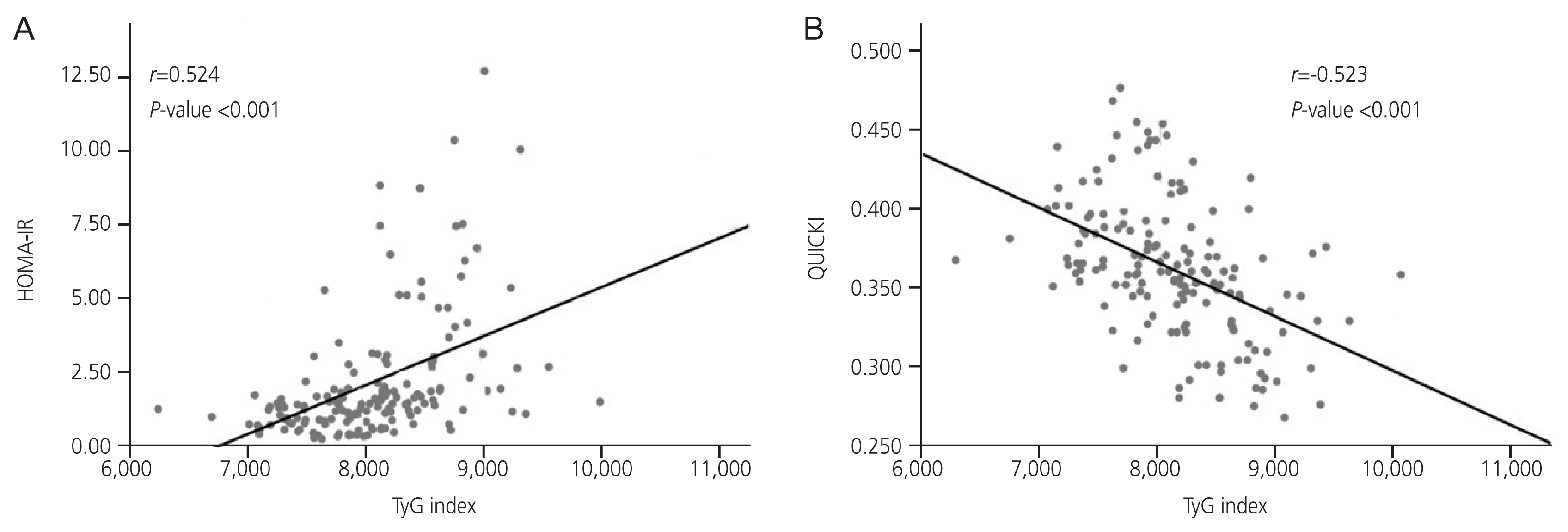 |
 |
- Search
| Obstet Gynecol Sci > Volume 66(4); 2023 > Article |
|
Abstract
Objective
Methods
Results
Notes
Ethical approval
This retrospective study was approved by the lnstitutional Review Board of the Inje University Haeundae Paik Hospital (IRB No. 129792-2014-035).
Fig. 1

Fig. 2

Table 1
HDL-C, high-density lipoprotein cholesterol; LDL-C, low-density lipoprotein cholesterol; TyG index, triglyceride and glucose index; TG-HDL, triglyceride to high-density lipoprotein cholesterol; HOMA-IR, homeostasis model assessment of insulin resistance; GIR, glucose to insulin ratio; QUICKI, quantitative insulin sensitivity check index.
Table 2
| TyG index | ||
|---|---|---|
| r | P | |
| Age | 0.138 | 0.074 |
| Body mass index | 0.471 | <0.001a) |
| Waist-to-hip ratio | 0.442 | <0.001a) |
| Cholesterol (mg/dL) | 0.347 | <0.001a) |
| Triglyceride (mg/dL) | 0.991 | <0.001a) |
| HDL-C (mg/dL) | −0.405 | <0.001a) |
| LDL-C (mg/dL) | 0.384 | <0.001a) |
| TG-HDL ratio | 0.936 | <0.001a) |
| Fasting glucose (mg/dL) | 0.349 | <0.001a) |
| Fasting insulin (μU/mL) | 0.516 | <0.001a) |
| HOMA-IR (fasting) | 0.524 | <0.001a) |
| GIR (fasting) | −0.501 | <0.001a) |
| QUICKI (fasting) | −0.523 | <0.001a) |
TyG index, triglyceride and glucose index; HDL-C, high-density lipoprotein cholesterol; LDL-C, low-density lipoprotein cholesterol; TG-HDL, triglyceride to high-density lipoprotein cholesterol; HOMA-IR, homeostasis model assessment of insulin resistance; GIR, glucose to insulin ratio; QUICKI, quantitative insulin sensitivity check index.
Table 3
| TyG index | ||||
|---|---|---|---|---|
| ra) | P-value | rb) | P-value | |
| Cholesterol (mg/dL) | 0.347 | <0.001c) | 0.278 | 0.001c) |
| Triglyceride (mg/dL) | 0.854 | <0.001c) | 0.866 | <0.001c) |
| HDL-C (mg/dL) | −0.292 | <0.001c) | −0.319 | <0.001c) |
| LDL-C (mg/dL) | 0.279 | <0.001c) | 0.251 | 0.003c) |
| TG-HDL ratio | 0.730 | <0.001c) | 0.706 | <0.001c) |
| Fasting glucose (mg/dL) | 0.250 | 0.001c) | 0.260 | 0.002c) |
| Fasting insulin (μU/mL) | 0.316 | <0.001c) | 0.330 | <0.001c) |
| HOMA-IR (fasting) | 0.315 | <0.001c) | 0.328 | <0.001c) |
| GIR (fasting) | −0.238 | 0.003c) | −0.273 | 0.001c) |
| QUICKI (fasting) | −0.348 | <0.001c) | −0.371 | <0.001c) |
TyG index, triglyceride and glucose index; HDL-C, high-density lipoprotein cholesterol; LDL-C, low-density lipoprotein cholesterol; TG-HDL, triglyceride to high-density lipoprotein cholesterol; HOMA-IR, homeostasis model assessment of insulin resistance; GIR, glucose to insulin ratio; QUICKI, quantitative insulin sensitivity check index.
Table 4
| Group 1 (n=85) | Group 2 (n=87) | P-value | |
|---|---|---|---|
| TyG index | 7.65±0.34 | 8.59±0.43 | <0.001a) |
| TG-HDL ratio | 0.80±0.30 | 2.70±2.50 | <0.001a) |
| Cholesterol (mg/dL) | 169.95±27.52 | 184.24±33.07 | 0.003a) |
| Triglyceride (mg/dL) | 49.94±14.41 | 130.39±80.61 | <0.001a) |
| HDL-C (mg/dL) | 65.77±15.68 | 54.44±13.71 | <0.001a) |
| LDL-C (mg/dL) | 93.00±25.68 | 109.26±29.12 | <0.001a) |
| Fasting glucose (mg/dL) | 88.39±7.12 | 92.19±6.30 | <0.001a) |
| Fasting insulin (μU/mL) | 5.79±3.22 | 14.27±11.18 | <0.001a) |
| HOMA-IR (fasting) | 1.29±0.82 | 3.30±2.69 | <0.001a) |
| GIR (fasting) | 19.85±10.66 | 10.86±7.91 | <0.001a) |
| QUICKI (fasting) | 0.38±0.04 | 0.34±0.04 | <0.001a) |
TyG index, triglyceride and glucose index; TG-HDL, triglyceride to high-density lipoprotein cholesterol; HDL-C, high-density lipoprotein cholesterol; LDL-C, low-density lipoprotein cholesterol; HOMA-IR, homeostasis model assessment of insulin resistance; GIR, glucose to insulin ratio; QUICKI, quantitative insulin sensitivity check index.
References
- TOOLS
-
METRICS

- Related articles in Obstet Gynecol Sci
-
The infertility treatment related with polycystic ovary syndrome.2010 October;53(10)
Anti-Mullerian hormone in women with polycystic ovary syndrome.2012 May;55(5)
Predictors of abnormal glucose tolerance among women with polycystic ovary syndrome.2012 July;55(7)



















